The Plaubel Makina 67 is a camera that I’ve long struggled to justify, but that simultaneously has on multiple occasions, given me the worst cases of gear acquisition syndrome I can recall! It’s medium format, which I rarely have a desire to shoot, yet I’ve always felt that if I was to shoot the format more it would be with one of these. The reputation of the lens, the size of the camera, it’s simplicity, the fact that it’s a rangefinder, and even it’s beautiful German functionalist design make for the perfect storm of ideal features for me… so in the end I buckled and bought one – but as a dedicated 35mm photographer and medium format sceptic, was it the right choice?
Medium format for a medium format sceptic?
“Medium format sceptic” is probably a slightly heavy handed way to describe me. Show me a random series of 10 images, 5 35mm and 5 medium format and I could probably tell you which are which. That’s possibly an exaggeration, but my point is that I know the look that’s achievable with medium format cameras, I know that 35mm rarely comes close, and I’d even go as far to say that I prefer the look of 120 to 35mm.
That confession out of the way, I also know that for every inch an image out of a medium format camera can look incredible, an image out of a 4×5 camera looks even more amazing; 8×10, more so still. But, with each one of these steps away from 35mm there are a new set of compromises that often make me revert to 35mm.
I used to have a Hasselblad, I liked it too, at least in theory. I couldn’t use the waist level finder – I’m crap with them – so I used it with an eye level finder. I got some ok results, but I didn’t really use it much. I just found it clunky and a bit of an ergonomic nightmare. It was also hard to carry, so I just didn’t carry it. I concluded that for the compromises it imposed on me, I might as well shoot 4×5. A 4×5 field camera isn’t much more of a pain to carry, and thanks to the f/2.8 maximum aperture of the blad lenses I had, I was only using it in decent enough light where even a f/5.6 lens on a 4×5 camera would be fine too – especially given the relative grain size of higher speed film in 4×5 format.
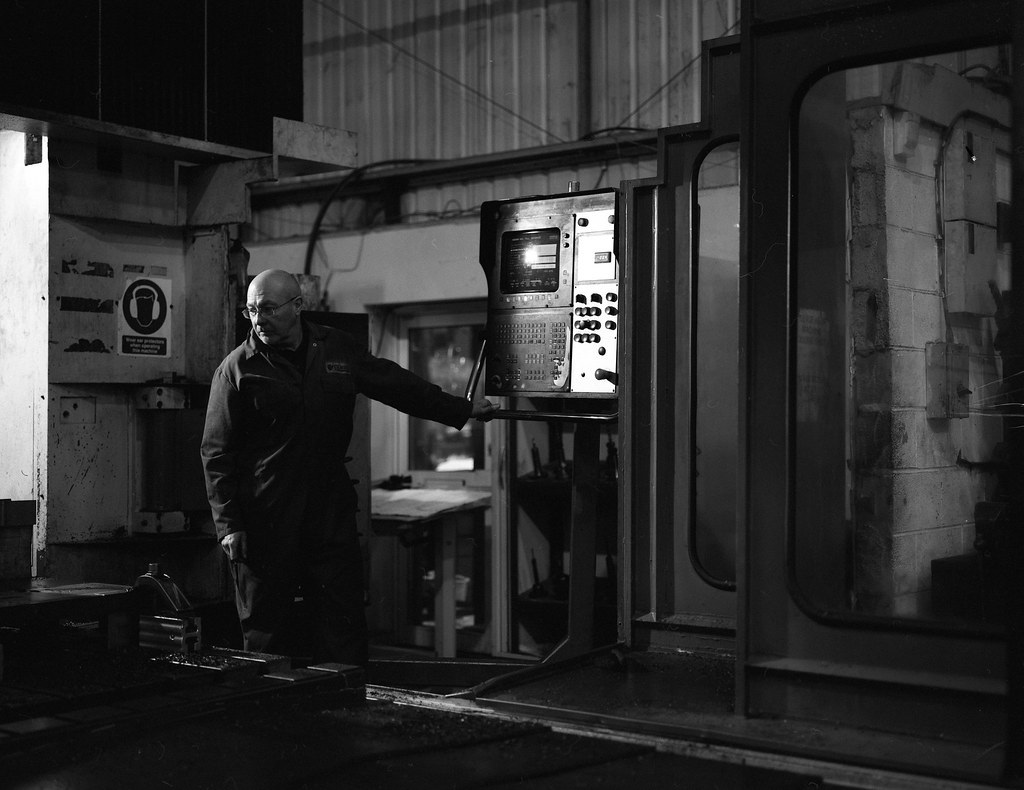
As such, I concluded that given the various pros vs the various cons, 4×5 was the best larger-than-35mm format for me. 35mm for portability, fast lenses, etc. 4×5 for ultimate quality, and that near-indescribable, 3 dimensional overall look that’s achievable from the format.
This did leave a little question mark though. What about the medium format cameras that were more portable? There’s the various Fujifilm “Texas Leica” cameras, and the 6×4.5 range they did, and the very late model folders that were also Voigtlander branded. There’s the Mamiya 6 and 7, the Bronica RF645, not to mention more vintage cameras such as the various Zeiss Super Ikontas, Voigtlander Bessa cameras etc. I could go on… but I’ll stop at the Plaubel Makina 67.
If you’d ever asked me about any of those cameras, l’d probably have mumbled something incoherent and ill-justified about trying a few of them but not really getting on with them. I’d have then gone a bit vacant looking and proclaimed “I’d bloody love a Plaubel Makina 67 though!”. To my mind – as I said at the beginning of the post – the Plaubel Makina 67 just seemed like the perfect combination of features for a medium format camera for me… The operative word there though is “seemed”; I’d never touched one, never even seen one in the flesh, I was just going off observations about it’s spec and my gut feelings. That was until I met Adam Laws one day on a photo walk in London. I handled his Plaubel Makina 67 then, and told him my feelings toward it. It must have stuck with him as he gave me first refusal when he came to sell it 6 or so months later…
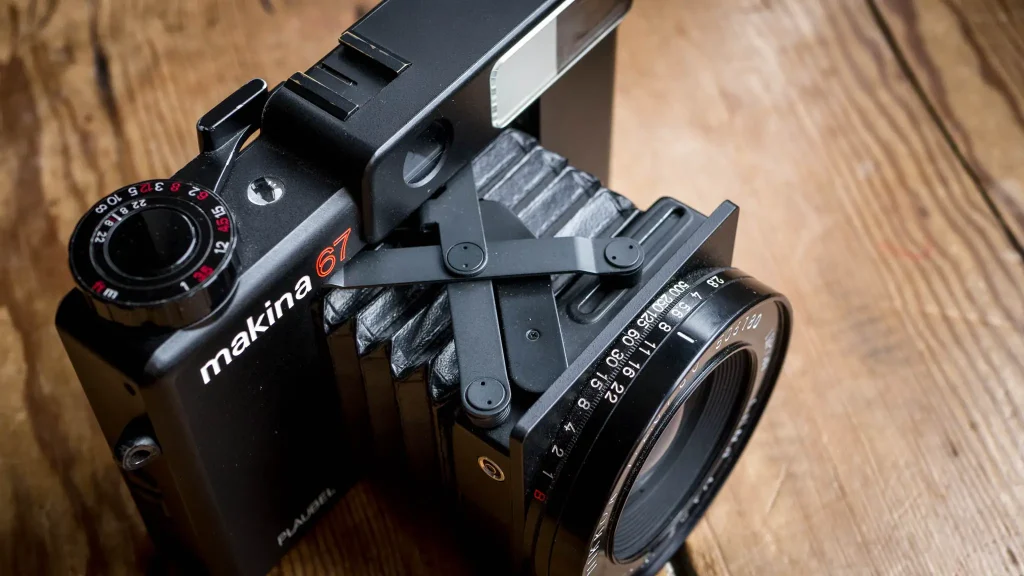
Owning a Plaubel Makina 67
I shall get to the “review” part of this post soon enough… I just wanted to mention what I have so far to set the scene and to give you an idea of the sort of photographer I am. If I haven’t made it clear, or you don’t already know, I’m essentially a 35mm (/“full frame” digital) photographer with a penchant for smaller, lighter weight cameras. Any medium or large format camera in my possession is only going to get rolled out where there’s a specific need for such formats.
On top of this, I feel that it’s also relevant to point out that I’ve had eyes for a Plaubel Makina 67 for a very long time. I specifically remember when it was first recommend to me. It was on a forum I used to run back in 2011 – you can see the thread here. They were expensive back then too, so although the thread doesn’t give much clue to this fact, I ended up going down the Fuji 645 path before eventually buying the aforementioned Hasselblad (a thread about that here) that eventually put me off shooting medium format. But, despite the hurdles along that path, this idea of a Makina 67 never left me – it’s actually probably the camera I’ve wanted and not owned for the longest period of time.
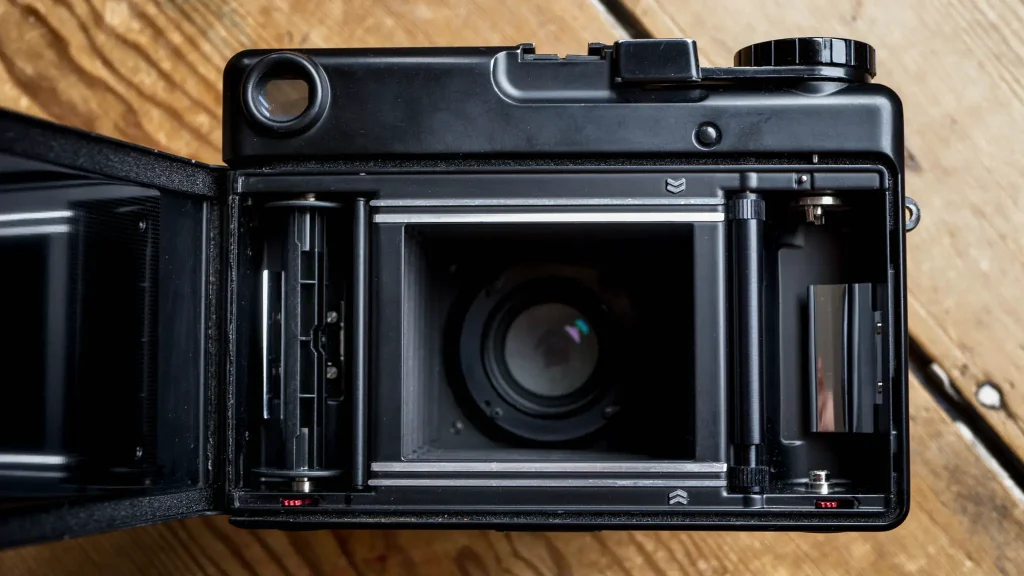
Saving it for a special occasion
The result of this is that once I actually had the camera, I almost felt like shooting it for the first time needed some sort of special occasion. That’s a little bit of an exaggeration, but I did feel like using it for the first time could wait until the right opportunity arose. As such, the Plaubel Makina 67 sat on my shelf unused for a good couple of months after I put my money down. I’ve mentioned this to a couple of people in passing on social media, one individual (who by some coincidence wanted to buy it off me) told me in jest (though I think he meant it) that it was wasted on me. A fair comment, but I’ve been quite relaxed about this lack of use. It’s just been my view that I didn’t want to force it on myself for the sake of just using it, and then not enjoy it because it wasn’t the right tool for the job.
The result of this mentality is that the bulk of this review is based on a series of lazy-day outings with the camera during my summer break from work – what better way to try a camera for a first time than whilst on a relaxing holiday with the family?
Spoiler alert! It went well enough for me to now feel comfortable to use the Plaubel Makina 67 for a much wider variety of applications, though I must admit, it wasn’t entirely a bed of roses… you know what they say about meeting your heroes…
The functionalist design
I’m going to kick off this Plaubel Makina 67 review with some thoughts about the design of the camera, not least because it’s a topic I’ve dipped into before. When I first got my hands on it, I was quite taken aback by how similar it looked to my Agfa 1035. I’d always thought these cameras looked alike, but in the hand it was even more striking. I set about finding out the back story, and ended up managing to get in touch with the son of the designer of the Agfa, and via him, the German designer who’d shaped the Plaubel Makina 67 in cooperation with the Japanese. You can read the full story here, but the gist is, there’s a very good reason why the two camera look so similar.
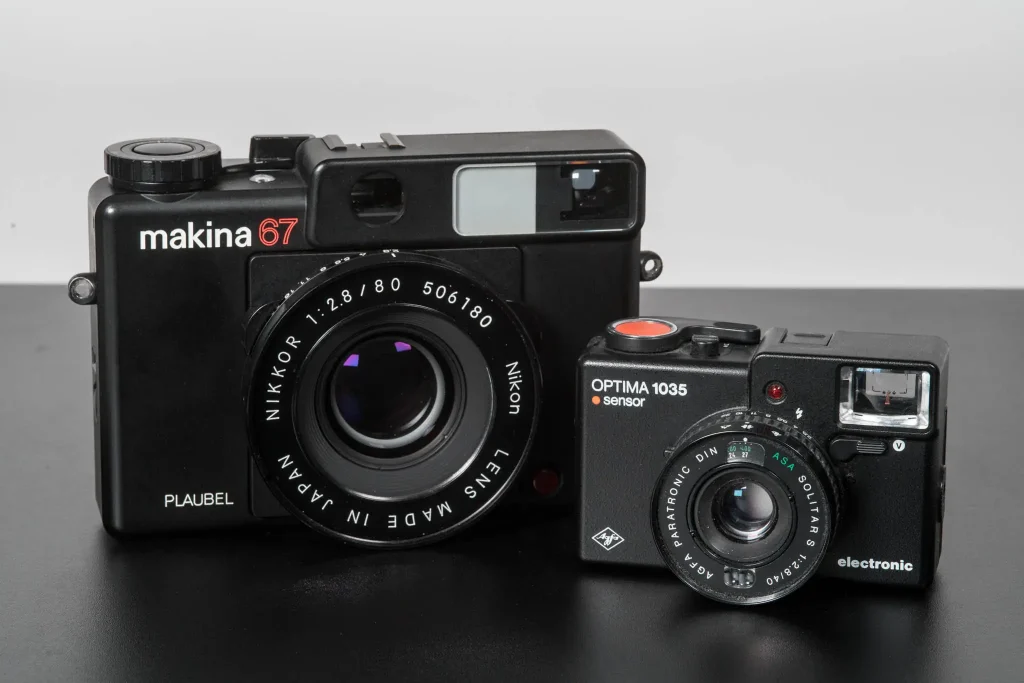
The size and weight
The story behind the design is one thing, how the design translates into a functioning camera is of course, another thing altogether. In fact, the funny thing about it’s physical form is that in real life I found it to be even more aesthetically pleasing than in the pictures – it really is a design masterpiece in my opinion, at least aesthetically speaking. But, I must admit, I was a little taken aback when it came to its size and weight.
In pictures, to me at least, it looks smaller than it actually is – even in my own pictures of it I think it looks smaller than it is. Now, it’s fair to say that when the lens is collapsed, the Makina 67 seems very thin, but that doesn’t mean that the other proportions of the camera are particularly small. With the lens in its extended position, or even just looking at the thing face on, it seems like a big camera to me. I think a part of this is due to the fact that proportionally, it just looks like a blown-up version of a small camera; Wayne Szalinski style. I posted the following photo on social media with the caption “I know everyone says the Makina 67 is small for a MF camera… it still seems pretty big to me…..”
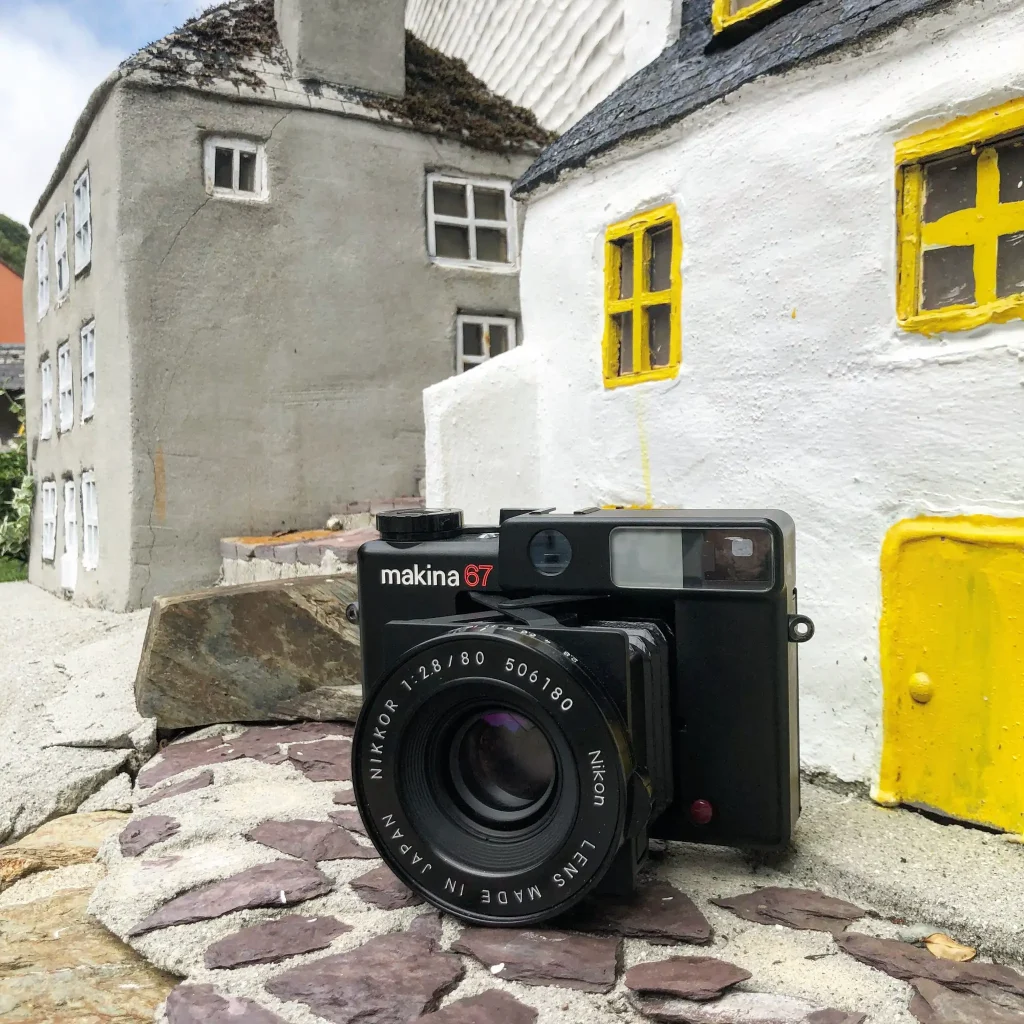
A few people seemed to miss the joke, tell me that all is relative, and that maybe I should try a Mamiya RB67 if I think the Plaubel is big… If you didn’t spot the joke, can you see the tiny little houses in the background…? that was the joke… get it? Just me? Ok, never mind. Bad jokes aside, I think something does get a little lost in translation about the size of this camera. It’s actually not that small, not when you compare it to something like a Zeiss Nettar – which all be it only 6×6 – is a very much smaller medium format camera. I think that the oft-repeated idea that this camera is small has come about due to the fact that for a relatively modern medium format camera it’s quite easy to carry. Its thinness when collapsed means that it is just small enough by one of its proportions to allow it to be carried in a small bag such as the Peak Design Field Pouch I’ve used to carry mine.
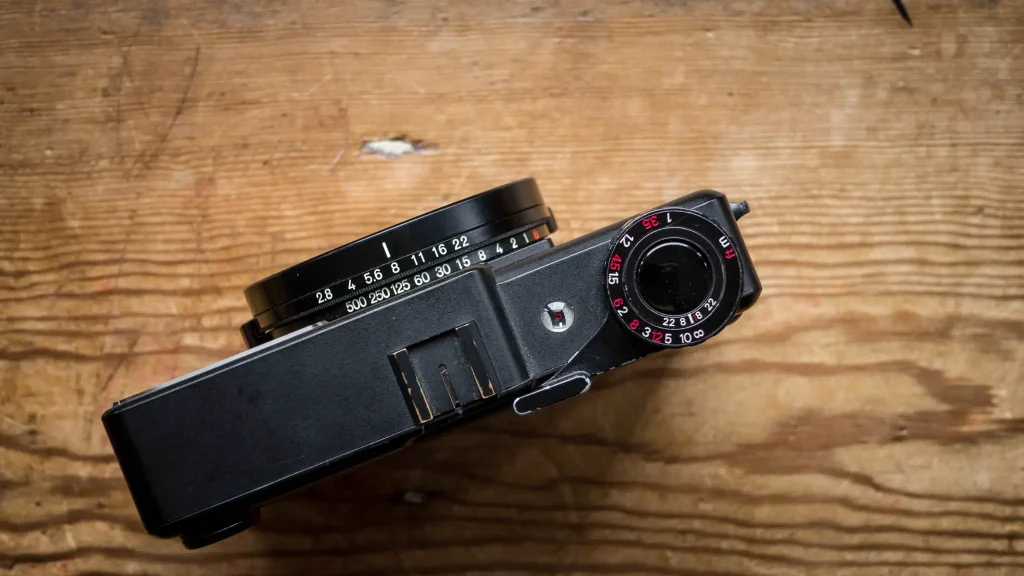
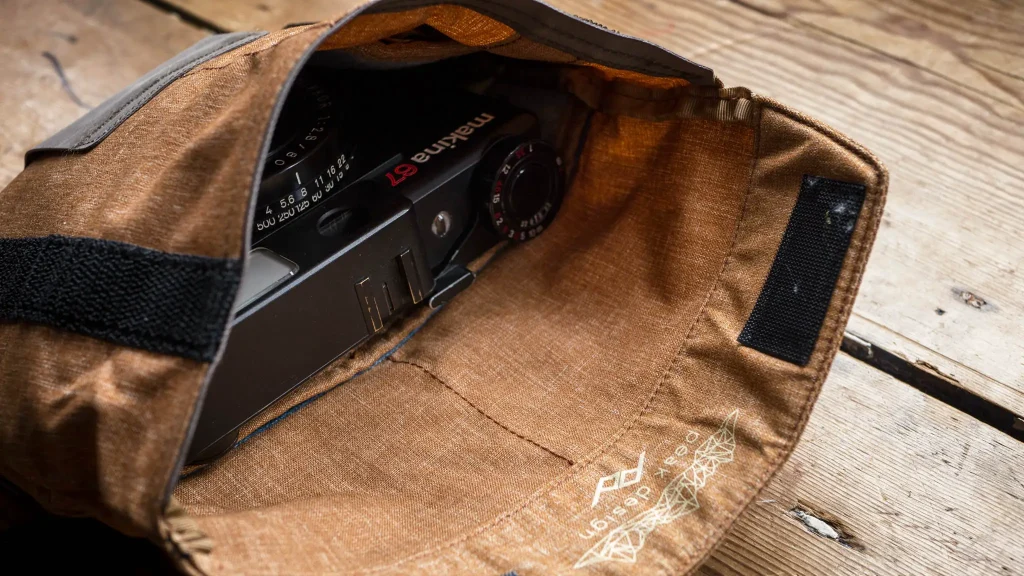
This is quite a big deal for me as a big part of the compromises I find with medium format gear comes down to how hard they are to carry. The Plaubel Makina 67 is definitely an easy to carry medium format camera, but, as I say, if you’re expecting a compact lightweight camera, you might find yourself quite surprised at how big and heavy it is. Unless of course you’re looking for a carry-everywhere alternative to your RB67… in which case, yeah, it’s quite tiny!
The design in use
Pros and cons of its size, weight and portability aside, I found the Plaubel Makina 67 to be a wonderfully simple camera to use. Though perhaps not surprisingly, it does have its quirks and shortcomings.
To use the Plaubel Makina 67, as I’ve alluded to, you first need to extend the lens. There’s a button on the front of the camera that releases the mechanism. The lens then pulls out on its lazy tongs and bellows and locks into the shooting position. To retract the lens, it’s simply the reverse of the process: press the button to unlock and push the lens-board back toward the body of the camera.
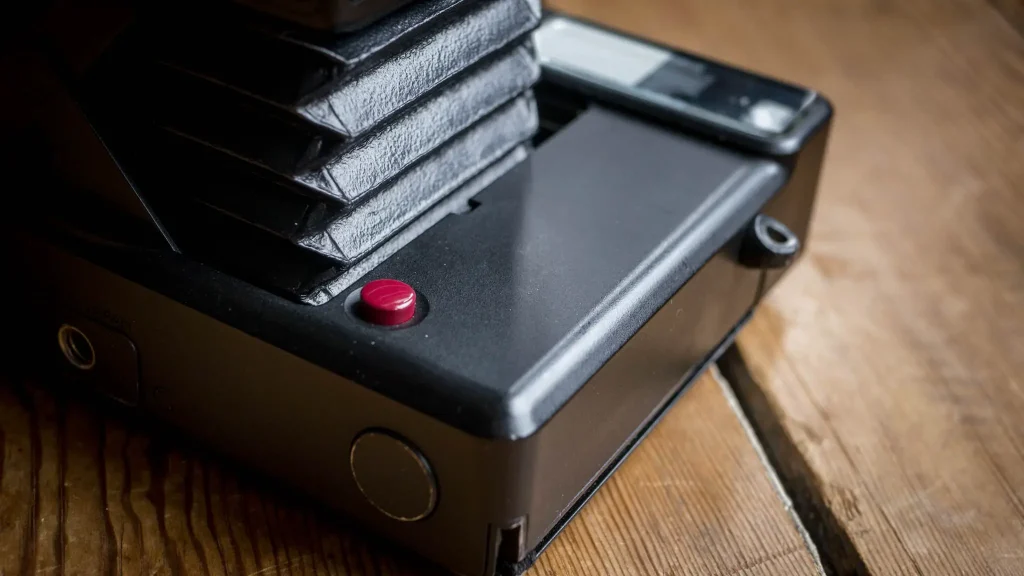
Simple, right? Well apart from the oft-quoted tip to refocus the lens to infinity before retracting the lens. I’ve heard this regarding a few medium format cameras, mostly Fujifilm, so just I took it as red to start with. That was until, without thinking after taking a rare portrait shot, I retracted it at the lens’s close distance. I shit myself for a second, and quickly (though gently) extended the lens to make sure I’d not broken anything. As it turns out, all was fine, so I played with it by gingerly extending and retracting the lens a few times at various focused distances. Nothing bad happened, and I couldn’t see any points of strain on the mechanism of the camera.
Slightly perplexed, I downloaded the manual to see what was said on the subject and found no mention of it there either. As is the standard approach to a lack of knowledge I then turned to the internet… I found this post on rangefinder forum where someone talks about the strain on the wiring rather than the mechanism itself. Interesting, but I’ve no idea who this person is and how valid the information they are sharing is. That being said, I’ve decided to continue to follow the tip when I remember to do so. This camera could be nearly 40 years old, erring on the side of caution when using it is probably a sensible approach to using it…
Focusing
Once the lens is extended – provided you’re used to a rangefinder patch for focusing – it’s all fairly self explanatory. Focusing is achieved by turning the dial around the shutter release. I found this slightly awkward to start with, but very quickly got used to it. I expected it to be quite difficult to turn, but in reality it only requires a fairly delicate amount of pressure. Rotation of the focusing dial simply controls the lazy tongs, moving the lens-board back and forth.
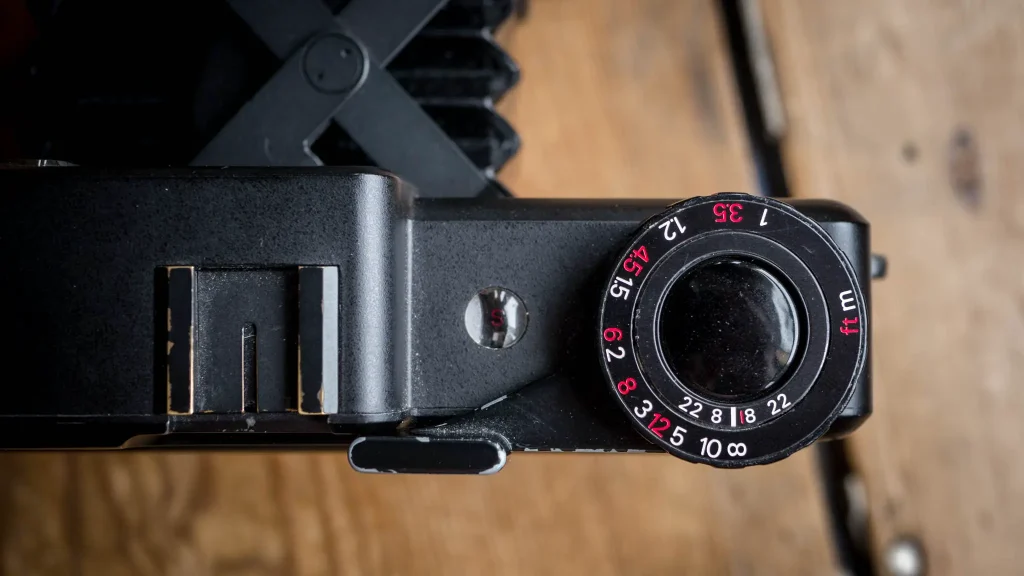
Focus is confirmed in two ways: there is a focus scale on the focus control and a rangefinder patch in the viewfinder. The focus scale is small and a little vague with depth marking for only f/8 and f/22, but in practice I found it didn’t let me down. The rangefinder patch in mine is very bright and quite large, unfortunately, it has an indistinct edge to it. This might not be an issue for some people, but as I’ve mentioned before here, my preference is for a solid edged patch so I must admit I’ve found it quite hard to focus close up. Practice, is likely the answer, but I’d definitely prefer there to be a better rangefinder patch.
Another small niggle I’ve found is with the parallax correcting frame lines. It’s only the top left hand corner of the lines that moves giving the sense that a little more guesswork is required for framing when compared to shooting many of the M-mount cameras I’m more used to. That being said, being used to shooting with rangefinder cameras, I’ve not had a sense of being caught out by it. My compositions have been fairly as expected, and with such a big negative, it’s not like a bit of cropping here or there would do much harm.
The light meter
Also found in the viewfinder is the light meter readout. The light meter is activated via a button under your thumb on the back of the camera with a simple three LED readout showing down the right hand inside of the finder window. To be honest, I’ve not used it a great deal, the batteries ran out just as I arrived on holiday and I’ve not found the time to replace them. With the meter as simple as it is, I’ve not missed it much – I’ll get around to trying it sometime, I’m sure. The exposure index for the light meter is set via a dial on the underside of the lens.
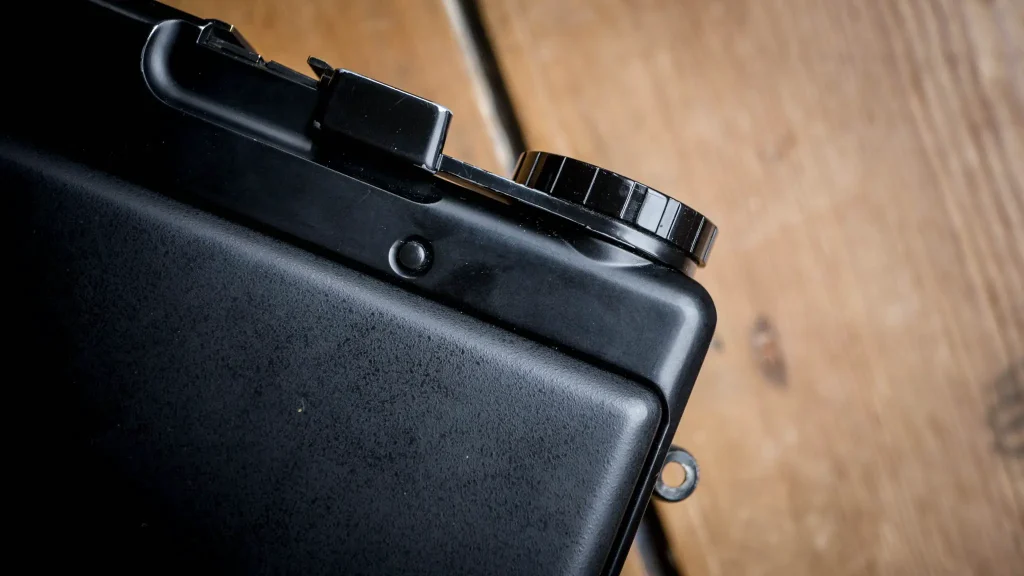
Controlling the camera
Shutter speed and aperture controls are both around the lens. Coming from more regular use of 35mm cameras this might take a bit of getting used to, though if you’re experienced with medium and large format cameras, it should be fairly easy to get your head around. I got used to it quite quickly, but I must admit there have been a few occasions when I’ve gone to adjust the shutter speed with the dial on the top of the camera, or tried to focus the lens by grasping for a non-existent control on its barrel. This really is a case of a lack of familiarity though – once I get used to using it more, I’m sure I’ll stop doing such sillies.
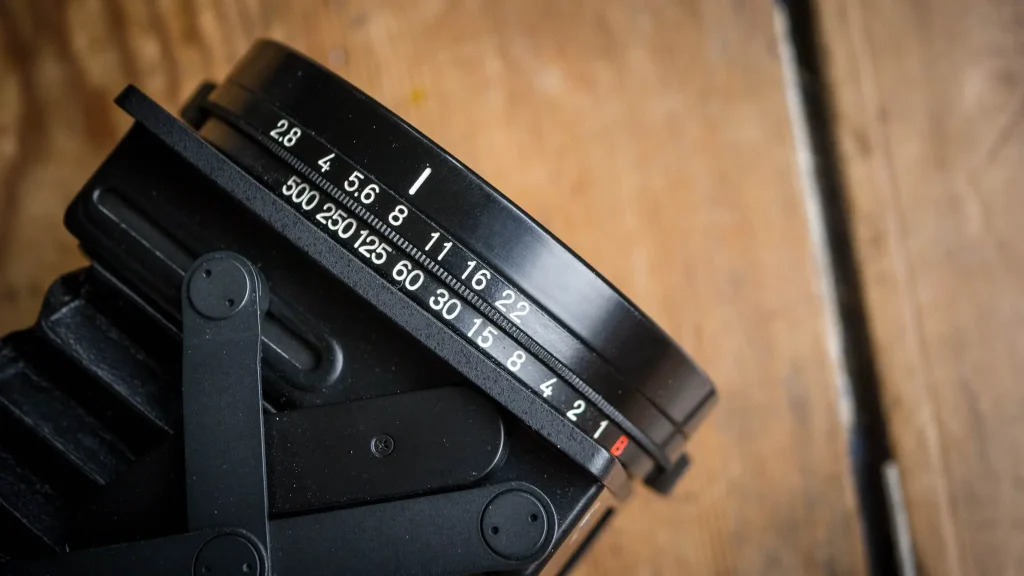
The film advance
The only time I usually mention the film advance of a camera is to talk about how smoothly they move on my Leica cameras. For some reason, this seems very shallow in the context of a review about a camera like the Plaubel Makina 67, especially as the smoothness is not the thing I want to talk about here – it’s not that it’s not smooth, it’s just doesn’t feel particularly relevant when discussing a camera with such an overtly functional design.
Anyway… I’d shot about 2 1/2 rolls of film before I remembered that Ray Larose had reviewed the later (but very similar) Makina 670 for me at some point in the past. I idly brought up the post on my iPhone an proceeded to read about how he’d ballsed up his first roll by not realising he needed to action the advance lever twice per frame. I can’t tell you the sinking feeling I had…
As it turns out, the later 670 (like the very early Leica M3) has a double stroke film advance. It was removed from the M3, supposedly as a previously assumed pressure on the mechanism was found to not be an issue. Conversely, in the Plaubel Makina 670 the double stroke mechanism was apparently added to alleviate pressure on the mechanism in the later one. Finding this out alleviated pressure in my brain too – panic over, I’d not ballsed up those first rolls.
Actually, as an aside, in the end it worked out rather well for Ray – his double exposures were, by some happy accident, quite stunning. So stunning, they were used on the cover of the 00 edition of Let’s Explore Magazine.
The point of mentioning all this (beyond highlighting Ray’s work, and LE mag) is to draw attention to the fact that it’s possibly wise to be gentle with the film advance – it’s large and feels quite heavy, so it’s probably not an idea to yank it around. To be fair, this is another one of those forum thread rumours turned sage advice, but just like with the lazy tongs, it can’t hurt to err on the side of caution can it?!
The lens
At f/2.8, it’s very much at the fast end of lenses found on medium format cameras, but it’s fixed at 80mm. I personally thrive on the limitation, and for what I’ve so far used the camera for find the focal length spot on.
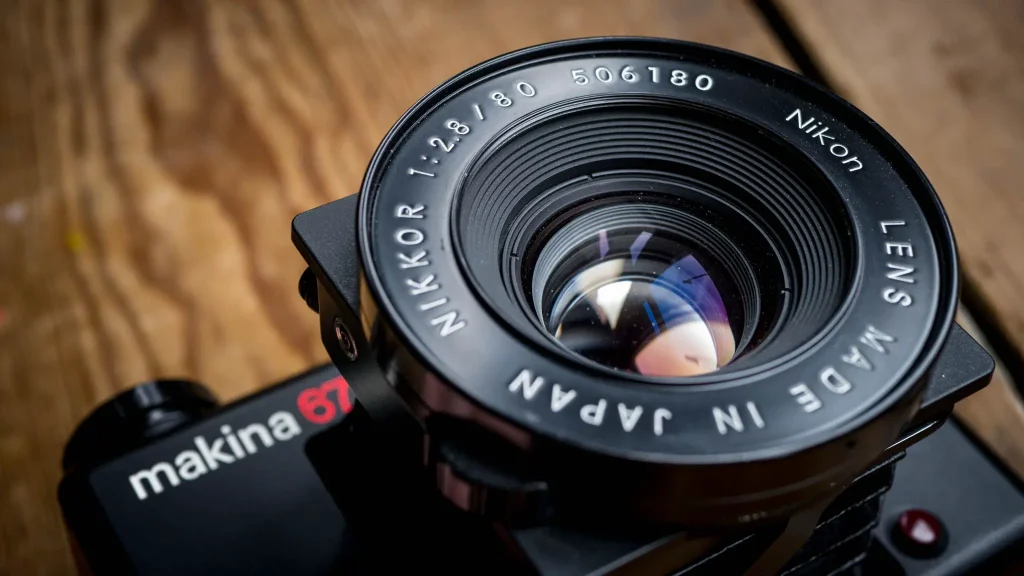
The focal length
If your used to shooting 35mm, or if like many your understanding of focal length works in terms of equivalence to 35mm, the easiest way to understand what this 80mm equates to is to work from a 1.8x crop factor. 45 x 1.8 = 81, so by that measure, this lens is equivalent to just shy of a 45mm lens on 35mm camera, or in simple terms, it’s a normal lens for the format.
Actually, there’s slightly more to the story than that. With the the Plaubel Makina 67 being a 6x7cm medium format camera (obviously), the frame height in landscape format or width in portrait format is slightly greater than an equivalent 2×3 format 35mm frame – it’s actually very close to a 4×5 ratio.
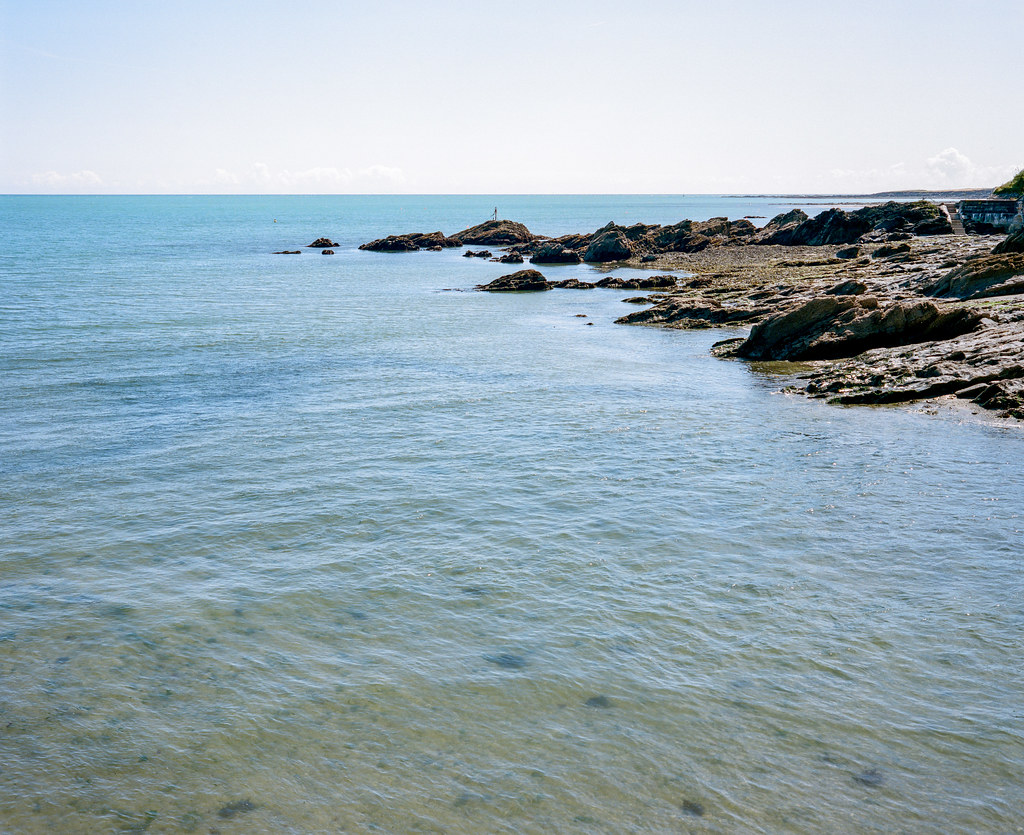
To get a slightly greater understanding of what this means in practice some slightly more complicated (by my standards at least) maths is involved. A normal focal length is derived from the diagonal length of the frame size. In 35mm terms we have a 24 x 36mm frame size, the diagonal of which is approximately 43.3mm. Hence a normal lens on a 35mm camera is of that focal length. Actually, in practice, we consider lenses around 40-58mm to be normal – 40mm being the wider end of normal, 58mm being the (extreme) longer end.
The Plaubel Makina frame size is 60 x 70mm, so a normal lens would be 92mm. The stated focal length is 80mm, so it’s fair to say that the 80mm lens on the Plaubel Makina is at the wide end of normal for its format. In practice, it feels it too. When I first picked up the camera, prior to doing the sums, I was expecting a normal field of view. In fact it felt wide angle. This is possibly because normal in my world means 50-55mm on a 35mm camera, and this lens is probably closer to 35mm than it is 50. This is far from an issue for me, and probably won’t be for anyone who’s happy picking up a fixed lens medium format camera, but I think it’s worth bearing in mind.
Aperture and depth of field
Of course, it’s still an 80mm lens with an f/2.8 maximum aperture on a 6×7 camera. Ignoring light gathering power for a second, to give you an idea of how the depth of field would compare to a lens on a 35mm camera, it’d be something like a 40-45mm lens with an f/1.7 maximum aperture. That’s very much an approximate because of the aforementioned difficulty in working out an exact focal length comparison, but it’s thereabouts. In short, wide open at closer distances, you can expect fairly shallow depth of field.
That being said, it’s also worth acknowledging that the lens/rangefinder focusing system only allows for a minimum focusing distance of 1m. What this means in practice is that your ~40mm f/1.7 equivalent lens is not going to give you head and shoulder portraits. Of course, if you’re a more traditional portrait photographer you likely wouldn’t want to get too much closer with a lens of this sort of field of view, as you’d find yourself edging toward unflattering distortion. At 1m, it’s still very possible to achieve a really nice bit of subject isolation with head and torso framing, but to my mind where this sort of field of view really shines is in more contextual portraiture.
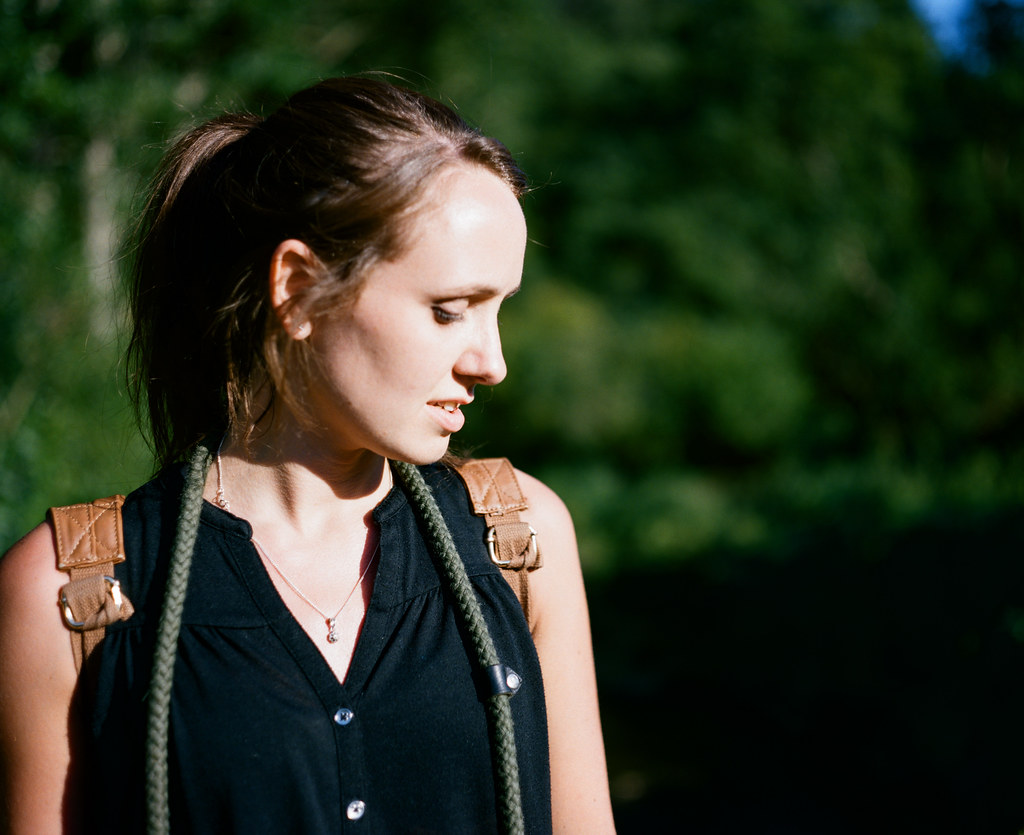
At the other end of the spectrum, for landscape work – as I’ve mostly been using it – this ~40mm equivalent has felt very natural and has given me the depth of field I’ve needed to achieve the results I’ve wanted. Stopped down to f/8 or f/11 I’ve found it easy to achieve the sort of depth of field required to give a sense of everything I want to be sharp being sharp. As mentioned, the focus scale is a little vague, and depth of field can feel a little tight but I found success erring toward slightly closer focusing for near subject sharpness and letting the far distances melt away slightly. I shoot a lot like this with my 50mm lenses on 35mm cameras so it didn’t feel entirely unnatural, just a little disconcerting for the first few rolls… It’s all well and good doing the maths and understanding what results should look like in theory, but seeing the results from the first few rolls was when the confidence to shoot it like this really kicked in.
Optical performance…
To say this lens is well suited to me would be an understatement. It seems, at least from the first few rolls, to be really contrasty. It’s hard to tell with only shooting Portra 400 so far, but it looks to be fairly – if not very – high resolution too. I’ve read in practically every review that it’s not quite up there with the 80mm f/4 lens off the Mamiya 7 in terms of resolution, but I’ve never shot that camera and can certainly say I’ve not been disappointed at all with the results from the Plaubel Makina 67, so that information is basically irrelevant to me. I’ve also so far not noticed anything in the way of other optical deficiencies such as distortion or even really much sign of vignetting or flare. The bokeh – at least as I’ve so far seen – is very nice too!
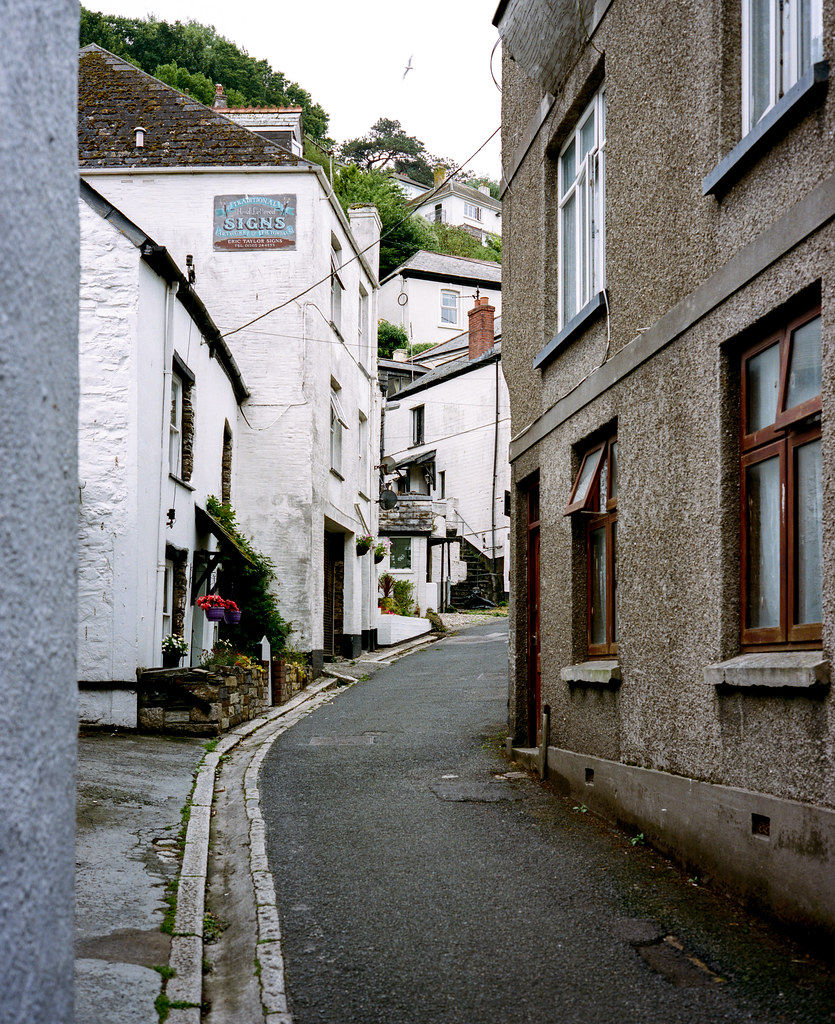
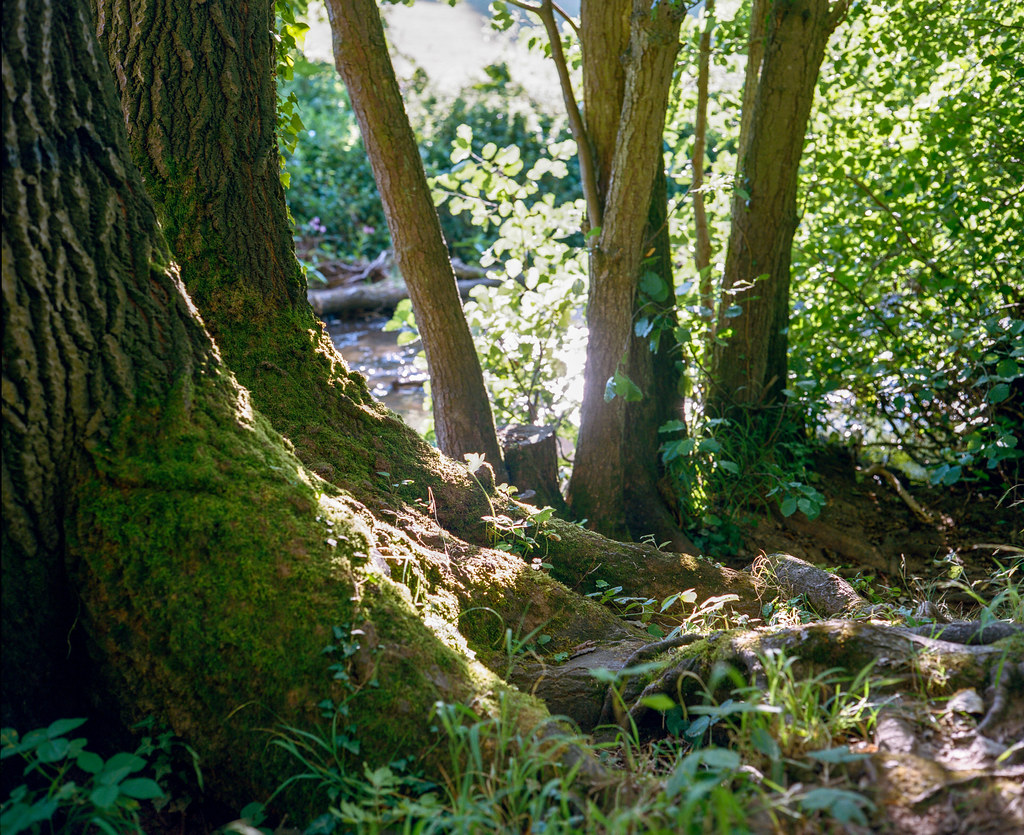
…and the medium format look
This is all great, but it’s also not unexpected. I’ve read a fair amount about this lens over the years, and am just happy it’s not been a disappointment. Actually, for my tastes, the most important factor here is contrast, and more importantly the 3 dimensionality it brings. I’ve talked a lot about 3d pop on this website, especially in relation to my favourite lens, the Zeiss 50mm ZM Sonnar. The ZM Sonnar is a lens that is quite often highlighted as having abilities to almost impersonate the “medium format look”. When people are saying this, they aren’t talking about resolution, obviously, as it’s a fairly low resolution lens. What I think they are talking about is the 3d look it brings.
I think 3 dimensionality is probably the biggest advantage of increasing film size. Medium, and even more so large format images just seem to have more depth to their images than smaller formats, but to my eye, and in my experience, this is definitely enhanced by a higher contrast lens. As mentioned, this is exactly what I find in the Plaubel Makina 67. The combination of high contrast optic and the 6×7 medium format just makes for stunning results in my opinion.
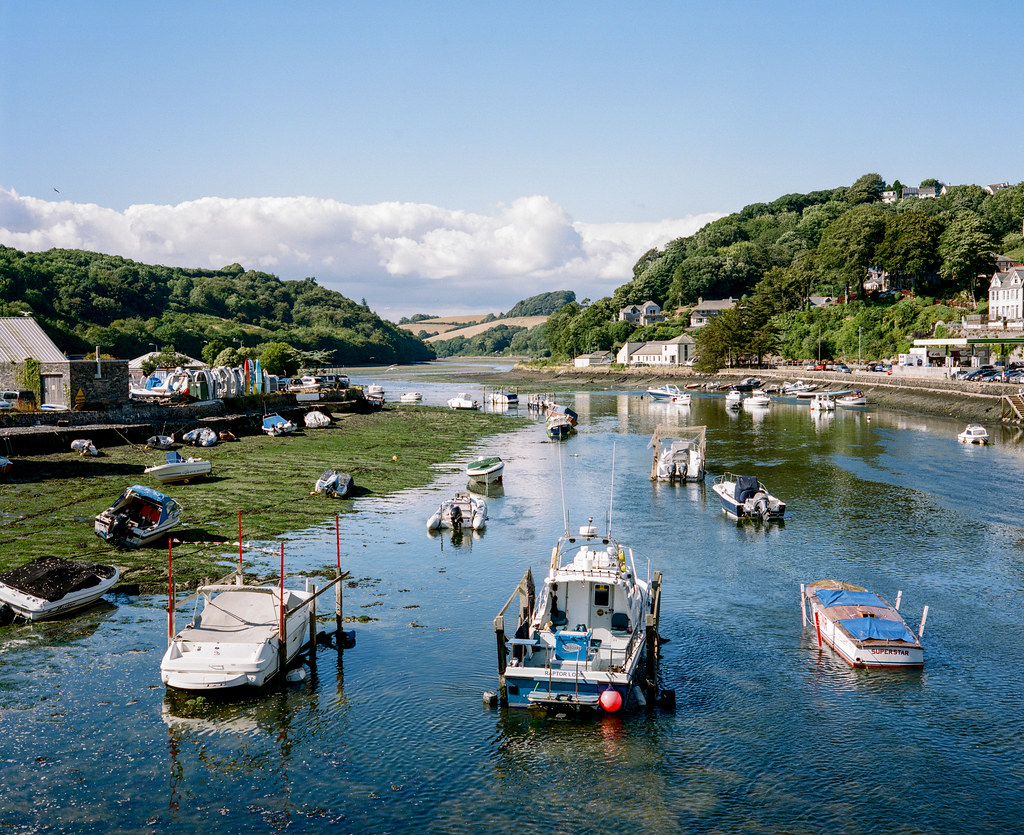
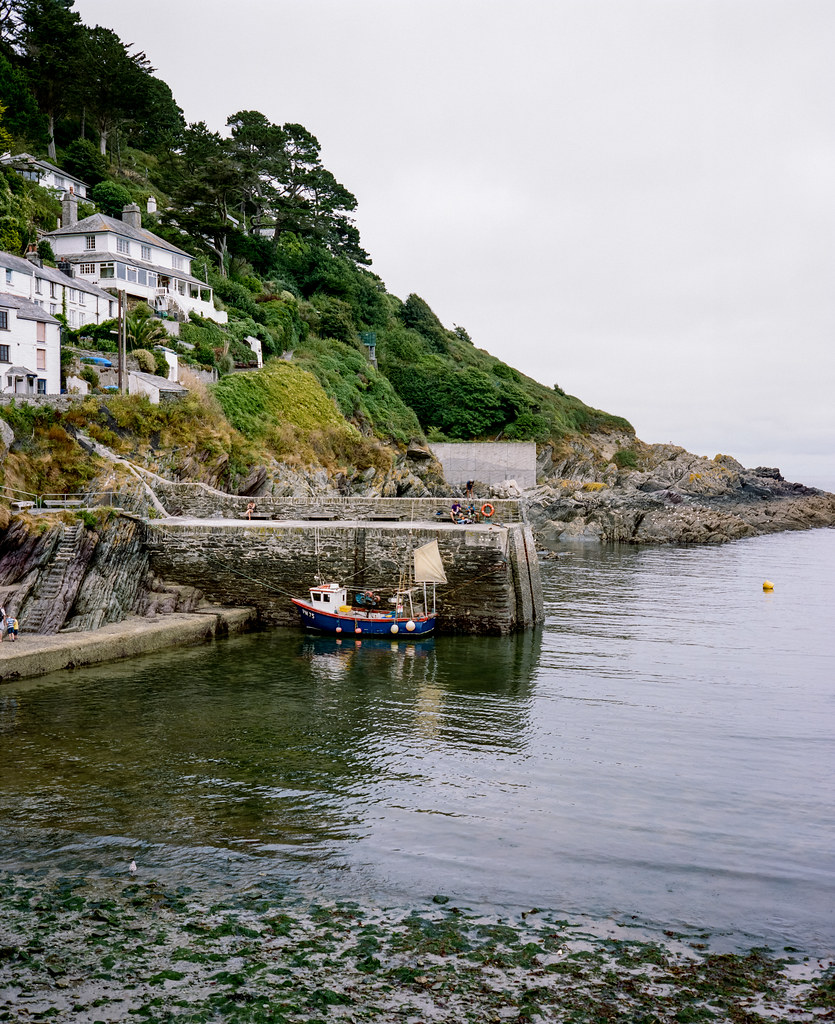
People often say that the advantages of medium and large formats are lost on the computer screen or when printed small, but I really quite fervently disagree with this sentiment. If you can’t see the 3d look in the images I’ve shared in this post on the screen of your phone or computer, then fine, I guess it is subjective… But to me it’s there in droves, and it’s the look I really aspire to achieve, especially in my colour photography – the Plaubel Makina 67 with a roll of Portra 400 shoved in the back makes this absolutely effortless!
More Photos
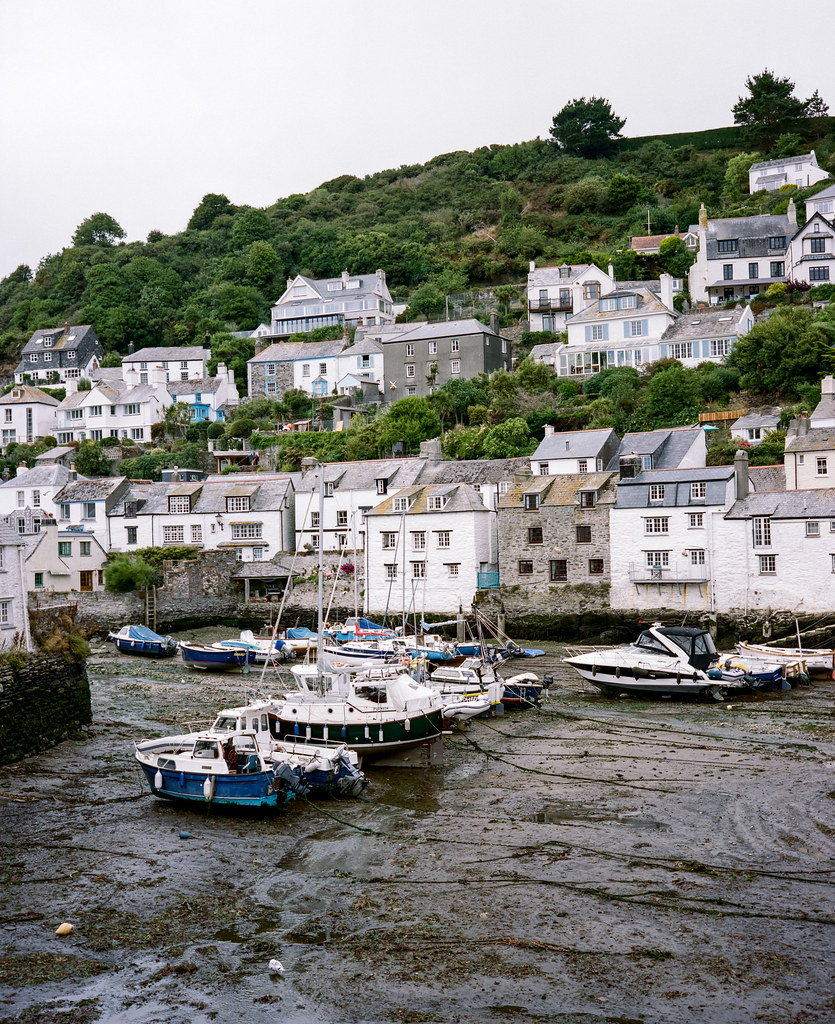
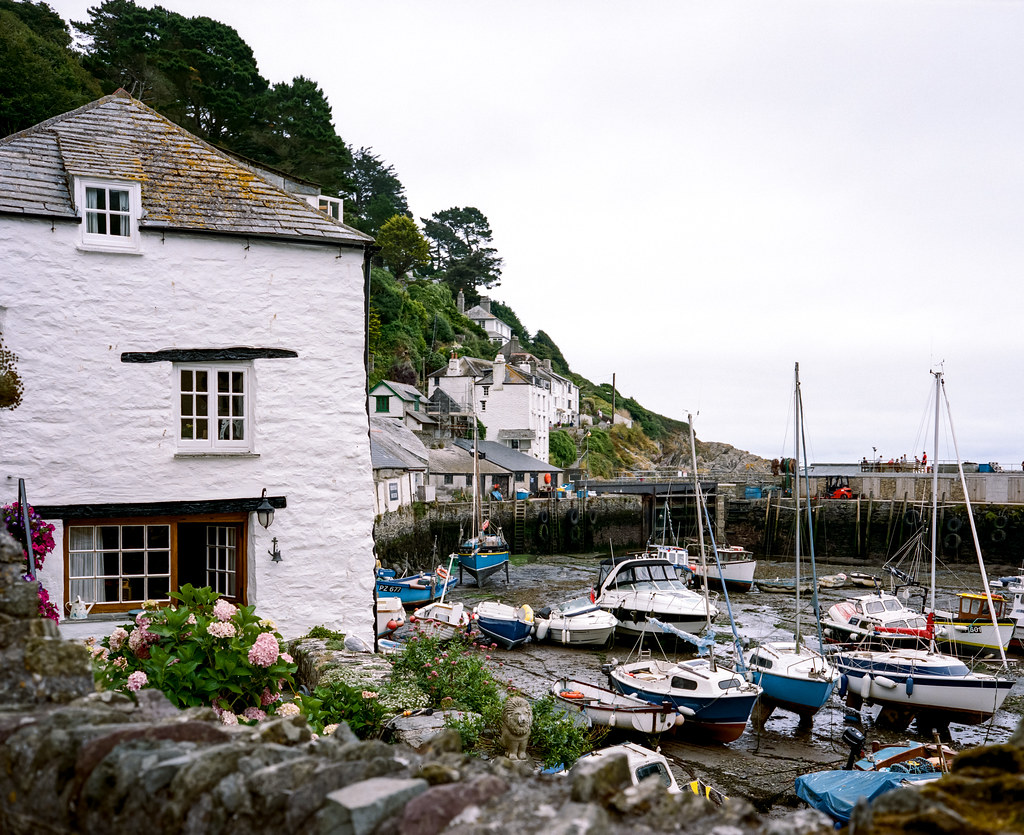
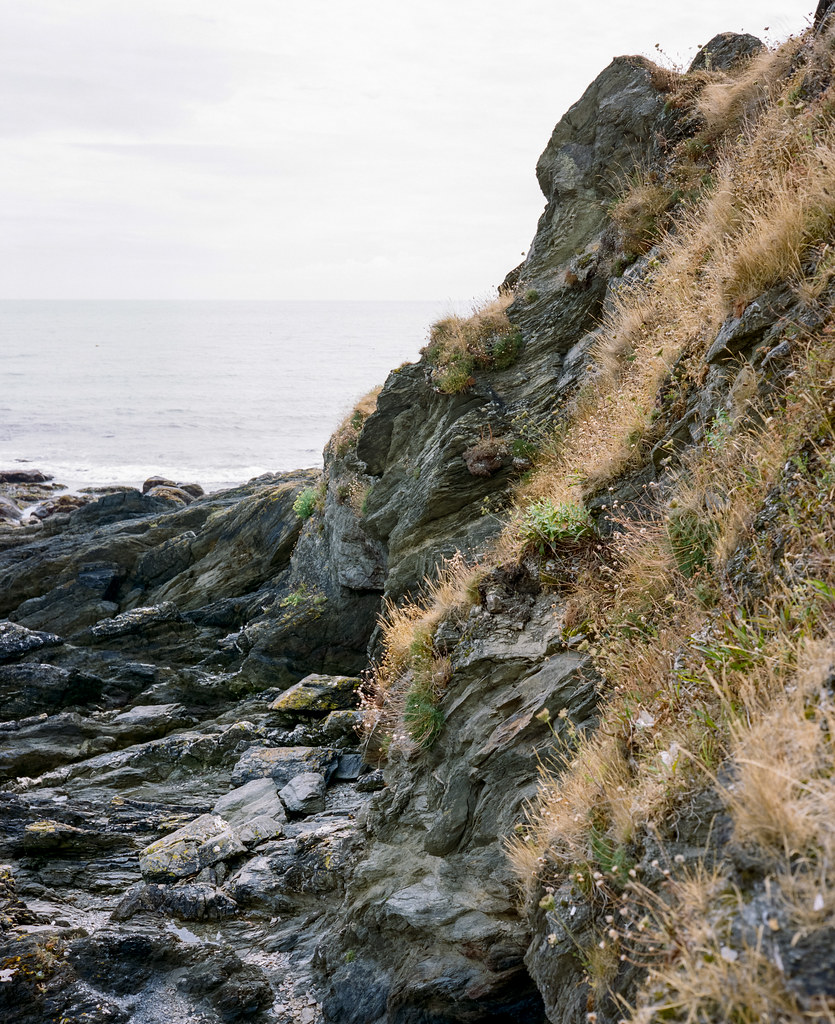
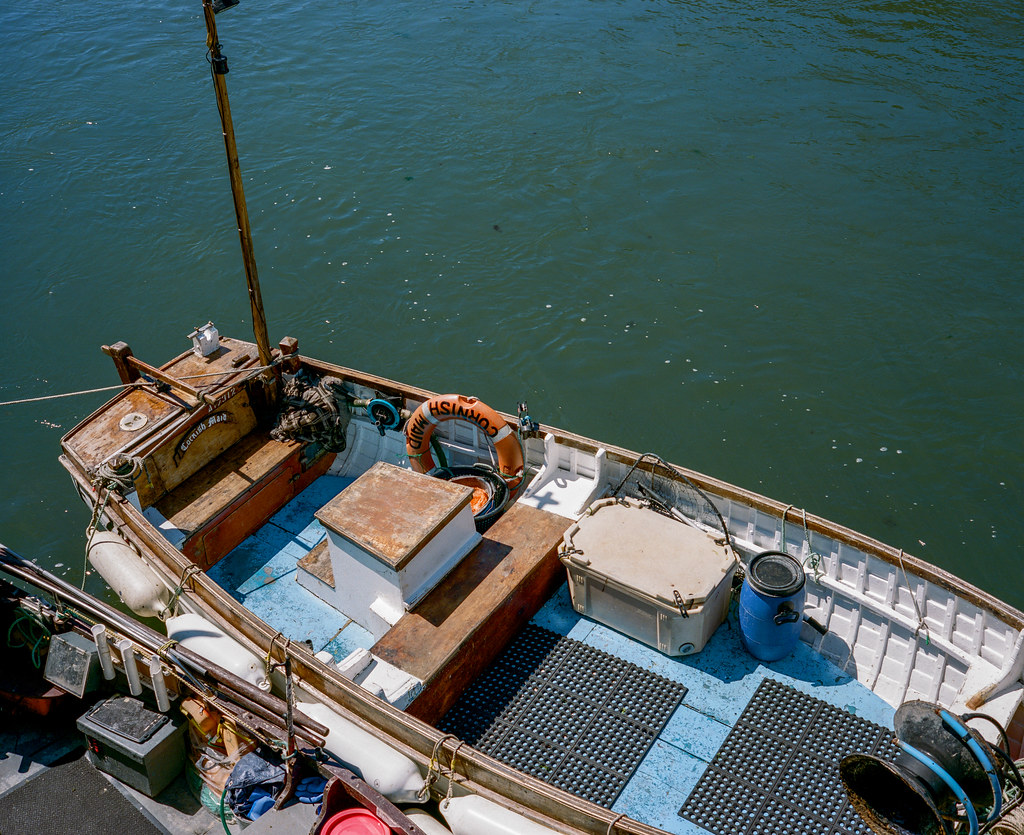
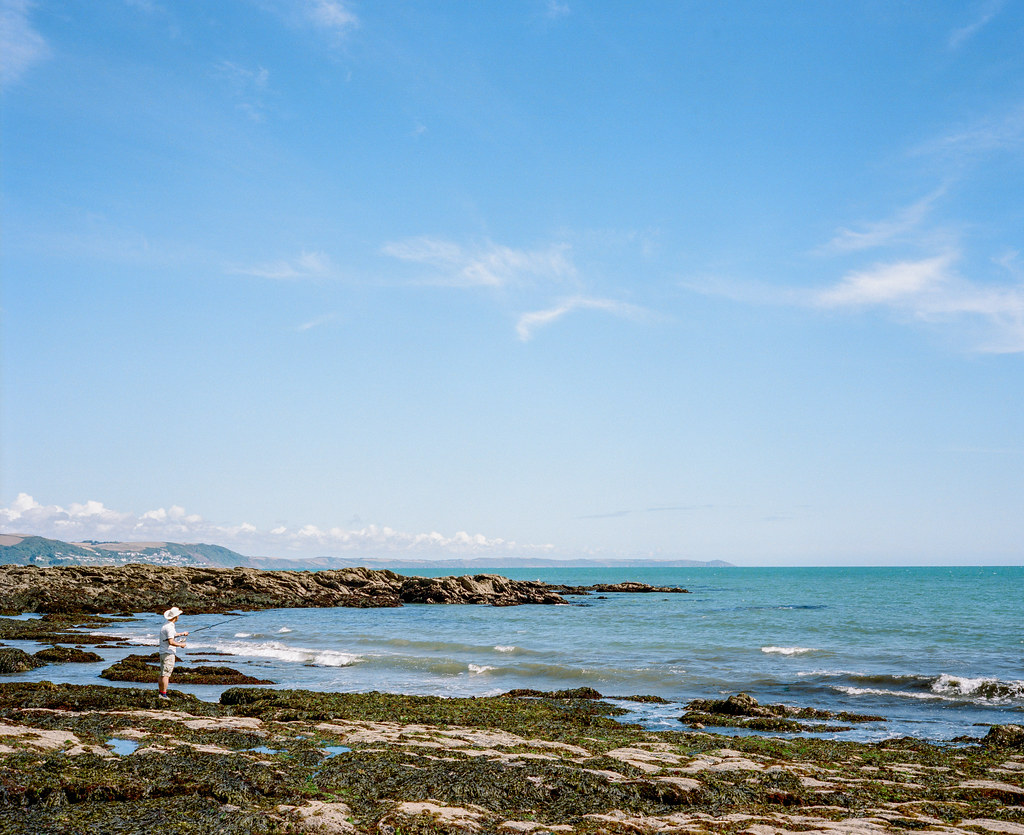
Skip to the end
In terms of the results alone, the Plaubel Makina 67, to my eye, is superb! I’ve only just said it in the last paragraph, but I’m going to say it again anyway: the Nikon optics combined with the film format make creating images that look a way I want them to seem absolutely effortless – and I really do say that without any hesitation whatsoever.
But, as I said earlier on in the post, using the camera hasn’t entirely been a bed of roses I might have hoped of. That being said, to say I’m disappointed in the user experience would be to overstate the negative parts of my feelings toward it. It is bigger and heavier than I’d probably prefer, but it’s still easy to carry, even by my standards. The rangefinder patch is indistinct at its edges, but it’s still bright and fairly easy to use within an otherwise very nice viewfinder. There might be mechanical shortcomings or areas where it’s fragile, but even if you overly concern yourself with them, they will only really slightly slow you down – and it’s not a camera I could imagine needing or wanting to use quickly anyway. I suppose what I’m trying to say is that where there are cons, they aren’t deal breakers. This camera is not perfect, but what camera is?!
To answer my own question at the beginning of the post, yes it was worth it. I have long doubted that I would get back into shooting medium format, but taking this particular plunge has seen an end to that perspective. The great thing is, I’ve met my camera-hero – it has given me a few reasons to question it – but I can’t think of a single other medium format camera that could or would work better for me. I can see me experimenting with medium format camera again more now, but this camera is pretty much the be-all and end-all of medium format for me, and that makes me feel pretty positive about it! This is not the last you will read on 35mmc about my experiences with the Plaubel Makina 67
Share this post:
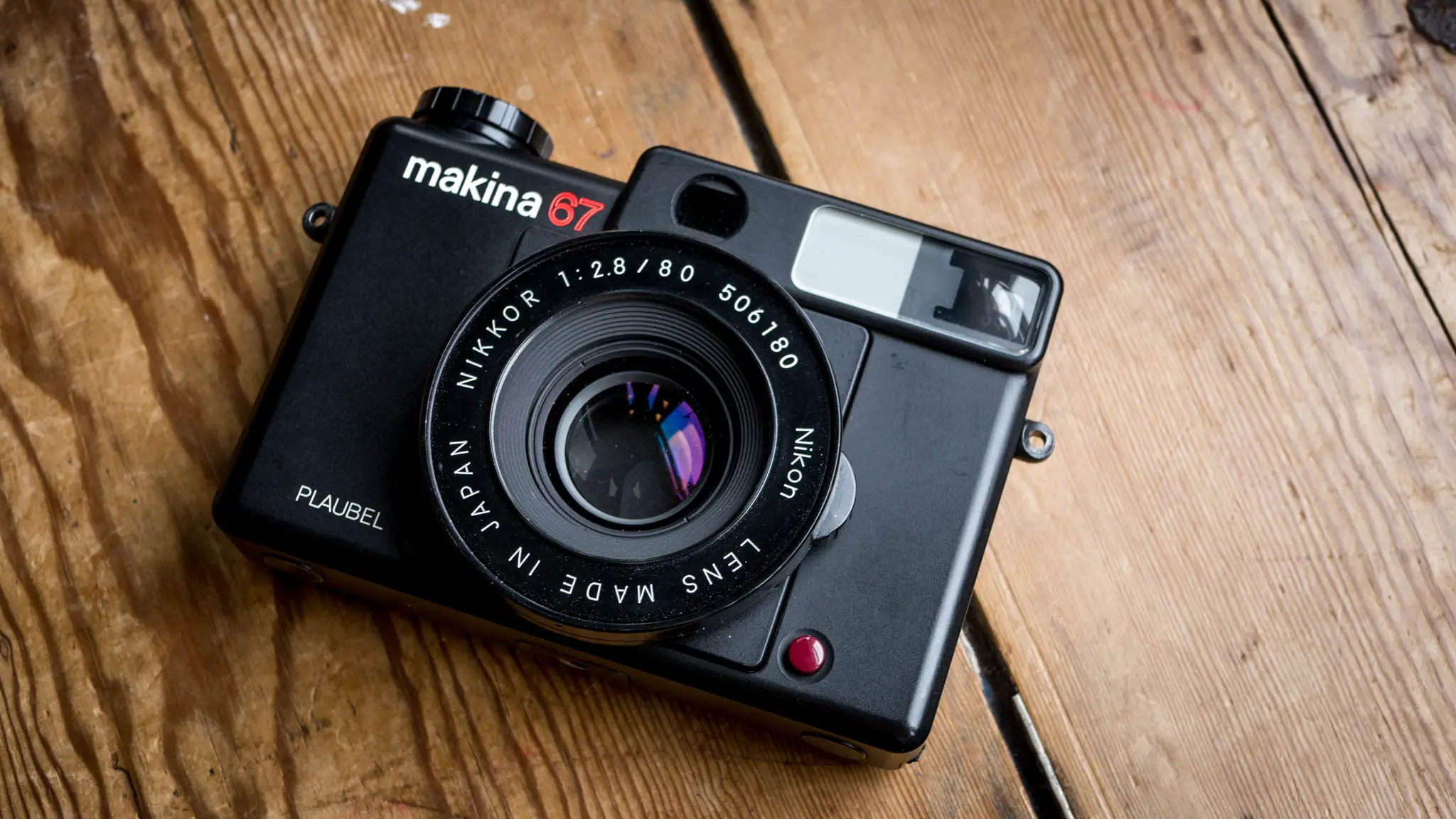








Comments
Terry B on Plaubel Makina 67 Review – the Beginning and end of my Journey into Medium Format
Comment posted: 19/08/2018
Despite its shortcomings, the Makina works for you and it is understandable to learn that you've found it is all you need when shooting roll film; if you want higher quality for a shoot when 35mm just won't do, then if 5x4 is just as easy as using the Makina in those circumstances, it makes sense to use the 5x4, especially when the 5x4 is also likely to have movements.
The allure of the 6x7 format is strong, but basically I'm a TLR man so the Makina doesn't press my button, so to speak. It is also very expensive for what it offers and lacks versatility. But it is in a niche market of relatively small modern cameras offering something more than conventional roll film folding cameras. It has its place, but at a price.
Importantly, from your images posted here, it does a fantastic job, too. The street scene and the shots with the boats all attest to this, but the woodland scene and those with rock formations seem to be far too contrasty for my taste.
Comment posted: 19/08/2018
Michael Kay on Plaubel Makina 67 Review – the Beginning and end of my Journey into Medium Format
Comment posted: 19/08/2018
Thanks for now causing the prices of these to skyrocket even more (along with Bellamy Hunt)..haha!
Half jokes aside...how did you rate the Portra? You got some quite pleasing results from what (to me) looks like some rather ordinary flat light. Or am I wrong here?
More Makina articles are very much appreciated. I'm just about to take my new 670 out for it's first spin.
We just might need to start a new Makina cult or sumfin'...lol
Comment posted: 19/08/2018
Comment posted: 19/08/2018
Comment posted: 19/08/2018
Ashley Carr on Plaubel Makina 67 Review – the Beginning and end of my Journey into Medium Format
Comment posted: 19/08/2018
Bronica SQa-i
Bronica SQa
Hasselblad 501cm
Mamiya 7II
Yashicamat 124g
Pentat 6x7 (mu)
And after all these I’ve settled, and feel most at home, with my current Pentax 67.
What clinched it for me was the availability of the superb Pentax 67 SMC 75/4.5 shift lens. The Mamiya RB/RZ offer a shift but I don’t like the form factor of that style.
I don’t miss the interchangeable backs of the Bronica’s and don’t mind the weight of the Pentax. I suppose the SLR style helps but it’s not the defining factor.
Also the lenses for the Pentax are superb and cost relatively little.
Comment posted: 19/08/2018
Ryan G Mason on Plaubel Makina 67 Review – the Beginning and end of my Journey into Medium Format
Comment posted: 19/08/2018
Comment posted: 19/08/2018
Miguel on Plaubel Makina 67 Review – the Beginning and end of my Journey into Medium Format
Comment posted: 19/08/2018
Comment posted: 19/08/2018
Nick Lyle on Plaubel Makina 67 Review – the Beginning and end of my Journey into Medium Format
Comment posted: 19/08/2018
A friend loaned me a Bronica RF645 with three lenses for a year, which is the nearest equivalent I have used to your Plaubel 67. I took it on long mountain hikes and found it to be a really nice camera both in terms of usability and image quality, but I wanted bigger negatives. Your Plaubel, or the Mamiya 7 and 6, or the gigantic Fuji RFs are the obvious solution, but I have resisted the relatively high cost of these cameras so far and have been assembling various DIY lightweight scale-focus cameras that use Graflok compatible roll-film backs and large-format style lenses mounted on a helical instead. Combined with add-on range finders and viewfinders these cameras are very portable, and the interchangeable film backs and other components make them very cost-effective and flexible tools as well. A handful of film backs, viewfinders, and a few lenses, can be combined into many different configurations.
The best of the classic folding cameras from the 1950s, as well as TLRs, also work very well for me, and I have stumbled on certain lenses among these cameras that deliver that contrast and 3D pop you refer to above. In particular the coated Zeiss Novar triplet on a 1954 Ikoflex is an astonishingly good lens, seemingly better than any of the Tessars I have tried. Modern films and modern post-processing are probably part of the reason these older lenses seem so good to me now.
I love the formats with tall aspect ratios in landscape orientation: 6x6, 6x7 and 5x4. The slightly wider than "normal" lenses in these tall formats feel more like normal human vision to me than 50mm in 135 format does. These taller landscapes work better for me in compositions which include taller elements, such as trees, boats, buildings and people. The tall format allows me to include more of these tall objects without needing to back off as much, which makes up for the slightly lower magnification. Even 645 format is a bit taller and more generous than the 2-3 aspect ratio.
Comment posted: 19/08/2018
adrian on Plaubel Makina 67 Review – the Beginning and end of my Journey into Medium Format
Comment posted: 19/08/2018
I can see what you said at the beginning about 35mm for more casual shots, and large format for (much better) quality images.
I personally use digital for those casual photographs and my Bronica SQ-Ai for when I want to feel like I'm "creating some piece of art". Looking through that viewfinder, combined with an orange or red filter, really makes you feel like a damn artist.
Anyway, another reason why I love my Bronica is because it gives me a completely different experience than 35mm or digital cameras. Yes, getting used to the WLF is painful at first, but I got so used to it that now I get confused when I'm using the screen on my digital camera!
So what I wanted to ask you is: do you use the Makina only because of the "medium format look" and higher quality?
Comment posted: 19/08/2018
Malcolm Myers on Plaubel Makina 67 Review – the Beginning and end of my Journey into Medium Format
Comment posted: 19/08/2018
Comment posted: 19/08/2018
Nick on Plaubel Makina 67 Review – the Beginning and end of my Journey into Medium Format
Comment posted: 19/08/2018
Comment posted: 19/08/2018
Neil on Plaubel Makina 67 Review – the Beginning and end of my Journey into Medium Format
Comment posted: 19/08/2018
Comment posted: 19/08/2018
Michael Kay on Plaubel Makina 67 Review – the Beginning and end of my Journey into Medium Format
Comment posted: 19/08/2018
http://www.arluewa-czens.de/
A real shame hey...
Comment posted: 19/08/2018
John Lockwood on Plaubel Makina 67 Review – the Beginning and end of my Journey into Medium Format
Comment posted: 19/08/2018
The old saw (pardon the pun) about "using the right tool for the job" certainly applies. As a professional, I started on the Bronica ETRSi system, then switched to the amazing Mamiya 6 (pre-MF version) and finally graduated to the Hasselblad 500 Series. This was over the course of a dozen years. Each camera system had its merits, but medium format film was the defacto standard for portrait and wedding photographers being the right blend of quality and portability.
Obviously the Makina 67, like my Mamiya 6, is very portable. It would absolutely be my choice for hiking the American Southwest whilst playing Ansel Adams. Your picture of the Makina 67 folded, made my heart skip a beat! What a sexy beast!
Do you shoot it handheld, or more deliberately with a tripod and cable release? I'd be tempted to shoot it like a Leica, but with the longer/slower lens that could be risky. Or certainly not optimal. Thoughts?
Perhaps I should submit a review of the Hasselblad 503CX with a dissertation on it's fantastic ergonomics?
Comment posted: 19/08/2018
Daniel Fjäll on Plaubel Makina 67 Review – the Beginning and end of my Journey into Medium Format
Comment posted: 20/08/2018
"..you know what they say about meeting your heroes…"
Thank you.
Comment posted: 20/08/2018
Rob Hawthorn on Plaubel Makina 67 Review – the Beginning and end of my Journey into Medium Format
Comment posted: 20/08/2018
Comment posted: 20/08/2018
Comment posted: 20/08/2018
Comment posted: 20/08/2018
Tom DiCorcia on Plaubel Makina 67 Review – the Beginning and end of my Journey into Medium Format
Comment posted: 20/08/2018
Comment posted: 20/08/2018
Adam Laws on Plaubel Makina 67 Review – the Beginning and end of my Journey into Medium Format
Comment posted: 21/08/2018
Comment posted: 21/08/2018
Lilianna Elrod on Plaubel Makina 67 Review – the Beginning and end of my Journey into Medium Format
Comment posted: 21/08/2018
The three-dimensionality is most apparent.
I quite understand your GAS for this camera!
Comment posted: 21/08/2018
Julian Love on Plaubel Makina 67 Review – the Beginning and end of my Journey into Medium Format
Comment posted: 26/08/2018
Comment posted: 26/08/2018
Rollin Banderob on Plaubel Makina 67 Review – the Beginning and end of my Journey into Medium Format
Comment posted: 29/08/2018
I bought an RB67 "kit" from an older photographers when I was young and did not use it much as such a beast. Still have the tripod. I tried film again last year with my T90 and dropped it again after two rolls - medium format would be the only one I'd stick with if I had the time as love the tonal graduation in the B&W's, and that MF look. For now will stick with my Zeiss 50mm ZM Sonnar for something close to that look.
Luis Sandoval on Plaubel Makina 67 Review – the Beginning and end of my Journey into Medium Format
Comment posted: 01/10/2018
Comment posted: 01/10/2018
Comment posted: 01/10/2018
Comment posted: 01/10/2018
Roger B on Plaubel Makina 67 Review – the Beginning and end of my Journey into Medium Format
Comment posted: 31/08/2019
The Mamiya 7 vs. The Makina 67 - Spoiler: the Makina Wins - 35mmc on Plaubel Makina 67 Review – the Beginning and end of my Journey into Medium Format
Comment posted: 04/11/2019
Robert Ante on Plaubel Makina 67 Review – the Beginning and end of my Journey into Medium Format
Comment posted: 16/11/2019
Again, thanks!
Comment posted: 16/11/2019
Scott Areman on Plaubel Makina 67 Review – the Beginning and end of my Journey into Medium Format
Comment posted: 29/03/2020
Film Fridays: Plaubel Makina 67 – The beginning and end of a journey into medium format - TodayPic on Plaubel Makina 67 Review – the Beginning and end of my Journey into Medium Format
Comment posted: 17/04/2020
Przemek on Plaubel Makina 67 Review – the Beginning and end of my Journey into Medium Format
Comment posted: 25/04/2020
Al Darley on Plaubel Makina 67 Review – the Beginning and end of my Journey into Medium Format
Comment posted: 13/05/2020
Lovely pictures too!
Claire on Plaubel Makina 67 Review – the Beginning and end of my Journey into Medium Format
Comment posted: 17/09/2020
Comment posted: 17/09/2020
susan huber on Plaubel Makina 67 Review – the Beginning and end of my Journey into Medium Format
Comment posted: 23/09/2020
for the spaces that are intimate and small. It is a superb camera in every way and demands a lover’s touch as the bellows are fragile. Of all the cameras I own, the MPlaubel stands out in its beauty, compact profile and ease of use. It is the camera most want to possess❤️.
Michael Lawlor on Plaubel Makina 67 Review – the Beginning and end of my Journey into Medium Format
Comment posted: 20/02/2021
Comment posted: 20/02/2021
Michael Lawlor on Plaubel Makina 67 Review – the Beginning and end of my Journey into Medium Format
Comment posted: 12/02/2023
Comment posted: 12/02/2023